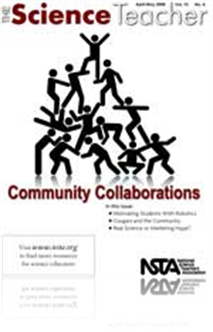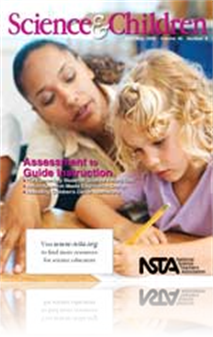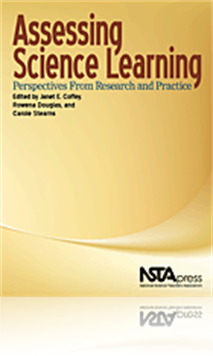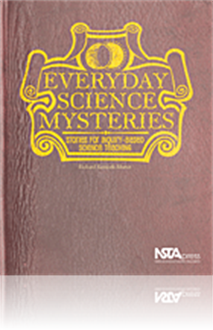All Resources
Journal Article
The Prepared Practitioner: Why Theories <em>Never</em> Become Laws
One of teaching’s challenges comes when the teacher communicates clearly and students appear to understand—but instead students ascribe different meanings to the words than intended by the teacher. This happens often when words have different mea...
Journal Article
Science Sampler: Nanoscale in perspective
Nanoscale science is a growing field, and to appreciate the work of scientists in this field, it is important for students to understand the scale of work being done. This activity, designed to bring nanoscale into the familiar macroworld, is from a ...
Journal Article
Action Research Meets Engineering Design
Engaging in sustained and collaborative action research is one way science teachers can build the bridge between improving student learning and their own professional learning as teachers and teacher-researchers. This article presents a series of pra...
Journal Article
Career of the Month: An Interview With GIS Specialist Ronald Wilson
In October 2002, in the midst of the terrifying Washington D.C. sniper attacks, a team of specialists was asked to help search for the suspects. Independent of the official investigation, the team analyzed and mapped attack locations to identify wher...
Journal Article
Methods and Strategies: Integrated Assessments for ELL
Despite the challenges posed by increased time, specialized vocabularies, and balance, integrating writing and drawing with science investigations is beneficial for teachers and students. This month’s column explains why this integrated approach is...
Journal Article
In a research collaboration with government biologists and university educators, K—12 students in the Cle Elum-Roslyn (CER) School District in eastern Washington are investigating where cougars go when their habitat gives way to new housing develop...
Journal Article
Scope on the Skies: Of moons and rings
When the planet Saturn is mentioned, most probably picture the spectacular rings above the planet’s equator. The rings are not unique to Saturn (planetary rings encircle the four Jovian planets), but they are the only ones visible from Earth. Despi...
Journal Article
Ask the Experts—April/May 2008
In this month’s column, the experts address the following questions: • How does temperature regulate the gender of sea turtles (and other organisms) as they incubate? Also, how can XX females become male turtles simply due to temperature lev...
Journal Article
How Accurate Are Student-Collected Data?
The purpose of this study was to teach upper elementary and high school students to monitor two estuarine creeks using an adaptation of the Georgia Department of Natural Resources Adopt-A-Stream protocol. Data collected by students were then compare...
Book Chapter
Improving Learning in Science With Formative Assessment
In recent years, the No Child Left Behind law has focused attention on student achievement in science across the United States, but there are more important reasons for being concerned with student achievement. The focus of this chapter is about how ...
Book Chapter
Using Standards And Cognitive Research To Inform The Design And Use Of Formative Assessment Probes
In their work with teachers, the authors use a process called Curriculum Topic Study (CTS) developed through our National Science Foundation–funded project, “Curriculum Topic Study–A Systematic Approach to Utilizing National Standards and Cogni...
Book Chapter
Assessment Linked To Science Learning Goals: Probing Student Thinking Through Assessment
The focus of this chapter is on how to design science assessment items that are linked to the content standards in Benchmarks for Science Literacy and the National Science Education Standards....
Book Chapter
Assessing Science Literacy Using Extended Constructed-Response Items
The authors’ goal in this chapter is to provide teachers with information that will make them better formative and summative assessors; better judges of the quality of state, national, and international assessments that their students experience; a...
Book Chapter
Aligning Classroom-Based Assessment With High-Stakes Tests
In this chapter, the authors will focus on the types of assessments found on high-stakes tests that can and should be used in middle-grades science classrooms. The authors provide a model for analyzing the kinds of information these types of assessme...
Book Chapter
This chapter summarizes some of the findings and recommendations of the National Research Committee (NRC) on Test Design for K-12 Science Achievement and is based on the committee’s final, book-length Report—Systems for State Science Assessment (...
Book Chapter
From Reading To Science: Assessment That Supports And Describes Student Achievement
This chapter is based on a presentation made to the National Science Teachers Association’s conference on assessment, “Science Assessment: Research and Practical Approaches for Grades 3-12 Teachers and School District Administrators”, held in N...
Book Chapter
What Research Says About Science Assessment With English Language Learners
This chapter addresses what research says about science assessment with English Language Learners (ELL) students. Specifically, the authors draw from our ongoing research and development efforts to promote science and literacy achievement of ELL stud...
Book Chapter
This chapter describes how elementary science staff in the Seattle Public Schools extended the district’s infrastructure and support system to help teachers prepare their students for the state assessment tests (Washington Assessment of Student Lea...
Book Chapter
Linking Assessment To Student Achievement In A Professional Development Model
This chapter reviews assessment as a key component in a professional development model implemented in a National Science Foundation–funded program entitled Toledo Area Partnership in Education: Support Teachers as Resources to Improve Elementary Sc...
Book Chapter
Using Assessment Design As A Model Of Professional Development
In this chapter, the authors describe a professional development model in which teachers collaborated with science content experts, assessment experts, and researchers to create a series of formative assessments to accompany each of their science uni...
Book Chapter
On the Role and Impact of Formative Assessment on Science Inquiry Teaching and Learning
In this chapter, the authors begin by describing what they mean by formative assessment and outline the potential and challenges of trying to implement and study this promising technique for scientific inquiry teaching. Next they describe their study...
Book Chapter
Using Formative Assessment And Feedback To Improve Science Teacher Practice
The authors in this chapter advocate use of the Reformed Teacher Observation Protocol (RTOP). This tool was originally developed for research on secondary physics teacher’s classroom practices, by science teachers for self-evaluation of their own a...
Book Chapter
Using Data To Move Schools From Resignation To Results: The Power Of Collaborative Inquiry
In this chapter, the author studies the impact of school communities’ analysis of multiple sources of student assessment data on their instructional decisions and organizational responses. The author poses simple questions that school groups can us...
Book Chapter
From Practice to Research and Back: Perspectives and Tools in Assessing for Learning
In this chapter, the authors draw on research and teacher practice to share the story of their own professional inquiry that led them to an exciting marginal space between the worlds of classroom teachers and education researchers. This chapter is in...
Book Chapter
Documenting Early Science Learning
Young children are fascinated by the natural world. They think about how things work, what is alive, and why some things change their shape and form. Science explorations such as planting, animal studies, and cooking are a natural part of early child...
Book Chapter
Using Science Notebooks as an Informal Assessment Tool
Science notebooks have been promoted as a means to enhance students’ scientific and literacy skills and as formative assessment tools for teachers. The author hopes this chapter will help you find ways to make science notebooks more effective tools...
Book Chapter
In this chapter, the authors discuss an instructional framework for scientific explanations, provide a set of rubrics to assess student work, illustrate types of feedback to give students, and describe how to develop assessment tasks to assess studen...
Book Chapter
Assessment Of Laboratory Investigations
The assessment of a laboratory investigation has two distinct components. The first is an evaluation of the quality of the laboratory investigation itself: Does it meet the criteria for a desired laboratory experience? The second is an evaluation of ...
Book Chapter
Assessing Science Knowledge: Seeing More Through the Formative Assessment Lens
In this chapter, the authors focus on classroom assessment practice, with emphasis placed on embedded diagnostic assessment. Embedded assessment activities require teachers and students to rethink their responsibilities in the classroom learning comm...
Book Chapter
Exploring the Role of Technology-Based Simulations in Science Assessment: The Calipers Project
In this chapter, the authors describe a project funded by the National Science Foundation, “Calipers: Using Stimulation to Assess Complex Science Learning.” This project is a two-year demonstration project that aims to use technology-supported �...
Book Chapter
This book, and particularly the stories which lie within, provide an opportunity for students to take ownership of their learning and learn science in a way that will give them a more positive attitude about science. In addition, it will serve to hel...
Book Chapter
The mystery here has a lot to do with the life cycle of the insect in the cereal and what the various stages were that Emma found in the box. However, it is important that children get to know more about the most populous animals on our planet. It is...
Book Chapter
Water makes up a very high percentage of all living things. This story is aimed at providing children with the opportunity to measure the surprising amount of water found in fruit. It also provides an opportunity for the teacher to emphasize the impo...
Book Chapter
Children as well as adults are usually intrigued by the ideas of bargains. More seeds for less money is often enough to convince them to buy a larger, cheaper package. In this case, the children are savvy enough to question the value of either packag...







